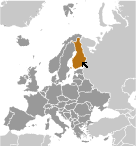World Atlas: Finland. On this page you can see the map, country flag and many detailed information about the people, history and economy of Finland.

Here you can find online selected information about the geography, inhabitants, government, economy and history of Finland. Included are selected statistics, an overview map and the detailed map of Finland. But let's start with the flag of Finland here:
Finland - Overview:
What you should know about Finland? Let's start with this: Finland was a province and then a grand duchy under Sweden from the 12th to the 19th centuries, and an autonomous grand duchy of Russia after 1809. It gained complete independence in 1917. During World War II, Finland successfully defended its independence through cooperation with Germany and resisted subsequent invasions by the Soviet Union - albeit with some loss of territory. In the subsequent half century, Finland transformed from a farm/forest economy to a diversified modern industrial economy; per capita income is among the highest in Western Europe. A member of the EU since 1995, Finland was the only Nordic state to join the euro single currency at its initiation in January 1999. In the 21st century, the key features of Finland's modern welfare state are high quality education, promotion of equality, and a national social welfare system - currently challenged by an aging population and the fluctuations of an export-driven economy.
Geography of Finland
 Where on the globe is Finland? The location of this country is Northern Europe, bordering the Baltic Sea, Gulf of Bothnia, and Gulf of Finland, between Sweden and Russia. Total area of Finland is 338,145 sq km, of which 303,815 sq km is land. So this is quite a large country. How could we describe the terrain of the country? This way: mostly low, flat to rolling plains interspersed with lakes and low hills. The lowest point of Finland is Baltic Sea 0 m, the highest point Halti (alternatively Haltia, Haltitunturi, Haltiatunturi) 1,328 m. And the climate is cold temperate; potentially subarctic but comparatively mild because of moderating influence of the North Atlantic Current, Baltic Sea, and more than 60,000 lakes.
Where on the globe is Finland? The location of this country is Northern Europe, bordering the Baltic Sea, Gulf of Bothnia, and Gulf of Finland, between Sweden and Russia. Total area of Finland is 338,145 sq km, of which 303,815 sq km is land. So this is quite a large country. How could we describe the terrain of the country? This way: mostly low, flat to rolling plains interspersed with lakes and low hills. The lowest point of Finland is Baltic Sea 0 m, the highest point Halti (alternatively Haltia, Haltitunturi, Haltiatunturi) 1,328 m. And the climate is cold temperate; potentially subarctic but comparatively mild because of moderating influence of the North Atlantic Current, Baltic Sea, and more than 60,000 lakes.
Inhabitants of Finland
Let's take a look how many people live in Finland. The number is: 5,518,371 (July 2017 est.). So this is not very populous country. Who lives here? Finn 93.4%, Swede 5.6%, Russian 0.5%, Estonian 0.3%, Romani 0.1%, Sami 0.1% (2006). What are the languages in Finland? Finnish (official) 88.3%, Swedish (official) 5.3%, Russian 1.4%, other 5% (2016 est.). And the religions: Lutheran 72%, Orthodox 1.1%, other 1.6%, unspecified 25.3% (2016 est.). How old are the people in average? 42.5 years. We have to add that this number is the median - so one half of the people is older than this, one half is younger. And what is their life expectancy (at birth)? This: 81 years. Where the people live in Finland? Here: the vast majority of people are found in the south; the northern interior areas remain sparsely poplulated. The major urban areas of Finland are: Helsinki (capital) 1.18 million (2015).
Government and Economy of Finland
The capital of Finland is Helsinki and the government type parliamentary republic. Let's take a look at the administrative divisions - 19 regions (maakunnat, singular - maakunta (Finnish); landskapen, singular - landskapet (Swedish)); Aland (Swedish), Ahvenanmaa (Finnish); Etela-Karjala (Finnish), Sodra Karelen (Swedish) [South Karelia]; Etela-Pohjanmaa (Finnish), Sodra Osterbotten (Swedish) [South Ostrobothnia]; Etela-Savo (Finnish), Sodra Savolax (Swedish) [South Savo]; Kanta-Hame (Finnish), Egentliga Tavastland (Swedish); Kainuu (Finnish), Kajanaland (Swedish); Keski-Pohjanmaa (Finnish), Mellersta Osterbotten (Swedish) [Central Ostrobothnia]; Keski-Suomi (Finnish), Mellersta Finland (Swedish) [Central Finland]; Kymenlaakso (Finnish), Kymmenedalen (Swedish); Lappi (Finnish), Lappland (Swedish); Paijat-Hame (Finnish), Paijanne-Tavastland (Swedish); Pirkanmaa (Finnish), Birkaland (Swedish) [Tampere]; Pohjanmaa (Finnish), Osterbotten (Swedish) [Ostrobothnia]; Pohjois-Karjala (Finnish), Norra Karelen (Swedish) [North Karelia]; Pohjois-Pohjanmaa (Finnish), Norra Osterbotten (Swedish) [North Ostrobothnia]; Pohjois-Savo (Finnish), Norra Savolax (Swedish) [North Savo]; Satakunta (Finnish and Swedish); Uusimaa (Finnish), Nyland (Swedish) [Newland]; Varsinais-Suomi (Finnish), Egentliga Finland (Swedish) [Southwest Finland]. Regarding the economy of Finland, important industrial products are metals and metal products, electronics, machinery and scientific instruments, shipbuilding, pulp and paper, foodstuffs, chemicals, textiles, clothing. Important agricultural products are barley, wheat, sugar beets, potatoes; dairy cattle; fish. The most important export commodities are electrical and optical equipment, machinery, transport equipment, paper and pulp, chemicals, basic metals; timbe and the most important export partners are Germany 13.1%, Sweden 10.6%, US 7.6%, Netherlands 6.7%, Russia 5.7%, China 5.2%, UK 4.8% (2016). The most important import commodities are foodstuffs, petroleum and petroleum products, chemicals, transport equipment, iron and steel, machinery, computers, electronic industry products, textile yarn and fabrics, grains and the most important import partners are Germany 16.9%, Sweden 16.1%, Russia 11.1%, Netherlands 8.6% (2016). How rich is Finland and how rich are people in this country? The most important number here is GDP per capita (PPP): $44,000 (2017 est.). This means the people are rich on average here. Let's add that this means Gross Domestic Product per person, which is recalculated with respect to the relative cost of local goods and services. And one more important number - population below poverty line: NA%.